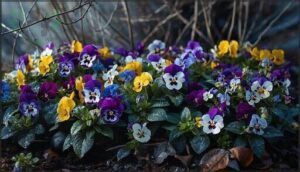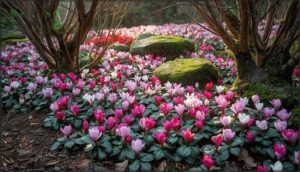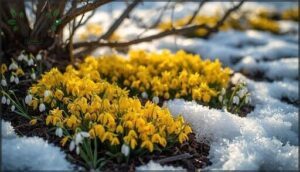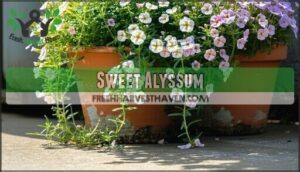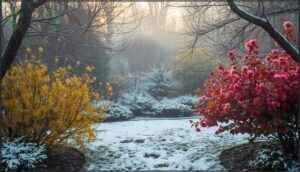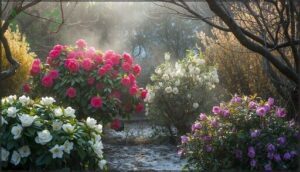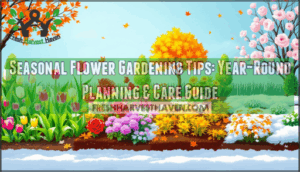This site is supported by our readers. We may earn a commission, at no cost to you, if you purchase through links.

From the cheerful faces of pansies carpeting southern gardens to the fragrant ribbons of witch hazel unfurling on bare branches, winter flowers transform bleak landscapes into unexpected pockets of color. They also provide critical food sources for winter-active pollinators when little else blooms, making them ecological workhorses wrapped in beautiful packages.
Table Of Contents
- Key Takeaways
- What Flowers Bloom in Winter?
- Popular Winter-Blooming Annuals and Perennials
- Winter-Blooming Shrubs and Trees
- Winter-Blooming Bulbs and Ground Covers
- Fragrant and Colorful Flowers for Winter Interest
- Frequently Asked Questions (FAQs)
- What flowers bloom in winter?
- What flowers make a difference in winter?
- Do flowers bloom in winter?
- Do perennials bloom in winter?
- What are winter blooming bulbs?
- What flowers can still bloom in the winter?
- What is the most common winter flower?
- Which one of the following flowers blooms in winter?
- What wild flowers bloom in winter?
- What flower is in season in December?
- Conclusion
Key Takeaways
- Many flowers, like pansies, hellebores, and snowdrops, bloom naturally during winter, bringing vibrant color when most gardens go dormant.
- Winter-blooming plants use special adaptations—like cup-shaped flowers and thicker stems—to survive freezing temperatures and attract pollinators when little else is flowering.
- Adding winter flowers supports local bees and can boost your garden’s curb appeal, plus reduce your stress and improve air quality.
- Popular winter bloomers include annuals, perennials, shrubs, trees, bulbs, and fragrant ground covers that thrive in cold weather and brighten up the landscape.
What Flowers Bloom in Winter?
Winter doesn’t mean your garden has to go dormant. You can actually grow flowers that thrive in cold weather, bringing color and life to your landscape when most plants are sleeping.
Even in winter, your garden can burst with color from flowers that thrive when most plants retreat into dormancy
Let’s explore what makes these hardy bloomers special, why you’d want to grow them, and how they differ from the flowers you see in warmer seasons.
Key Characteristics of Winter-Blooming Flowers
Winter flowering plants stand apart through exceptional cold hardiness, allowing blooms between −5°C and 10°C. Their flowering timing depends on vernalization—extended cold exposure that triggers blooming. You’ll notice distinct morphological features like cup-shaped flowers that trap heat and thicker stems for insulation.
These cold weather plants also show clever pollinator adaptation, with fragrant blooms attracting winter-active bees and flies. Bloom duration generally spans 3–6 weeks, creating lasting winter interest throughout the blooming season. Some plants, like Hellebores, offer evergreen foliage throughout the year.
Benefits of Growing Winter Flowers
Growing colorful blooms in your winter garden delivers real landscape enhancement, boosting curb appeal by roughly 19%. You’ll support pollinators like native bees during scarce months, while enjoying wellbeing benefits—winter garden visits measurably reduce stress and lift mood.
These plants also provide air improvement by filtering indoor pollutants. Plus, economic impacts show flower growers can increase revenue by 25% through winter cultivation. The National Garden Scheme promotes garden visits’ health benefits.
How Winter Blooms Differ From Spring and Summer Flowers
Beyond boosting winter curb appeal, you’ll notice cold-season blooms have unique winter flower characteristics that set them apart. Winter flowering plants thrive through specialized survival strategies:
- Cold tolerance – Winter blooming flowers endure temperatures as low as −4.6°C, while spring varieties require gentler conditions.
- Pigmentation impact – Deeper reds and yellows heighten visibility against snow.
- Flowering triggers – Growth longevity extends through vernalization (0–14°C cold exposure), unlike spring flowers responding to longer daylight.
These winter bloom characteristics support limited pollination needs when insects are scarce.
Popular Winter-Blooming Annuals and Perennials
When winter arrives, you don’t have to settle for a barren garden. Several annuals and perennials keep blooming through the coldest months, bringing splashes of color when you need them most.
Here are five reliable options that’ll brighten your winter landscape.
Pansies and Violas
Looking to add cheerful color to your winter garden? Pansies and violas are reliable cold weather plants that shine in southern climates, offering multiseason interest from December through early spring.
These self-cleaning annuals thrive in USDA zones 8–11, with impressive winter hardiness down to 45°F soil temperatures.
Space pansies 6–8 inches apart and violas 4–6 inches to improve planting density and keep your winter flowers blooming strong for months.
Cyclamen
In shade gardens where winter blooms are rare, cyclamen varieties like C. coum and florists’ cyclamen (C. persicum) offer delicate upswept petals from late November through March. These compact winter-flowering plants establish autumn foliage first, then create dense floral groundcover under 6 cm tall. For best winter hardiness, maintain night temperatures between 43–59°F to support continuous winter flowers in your winter garden.
- Compact Height: Stays under 6 cm, perfect for borders
- Extended Bloom: Flowers persist from December to March
- Shade Tolerant: Thrives where other winter blooms struggle
- Early Display: Blooms before spring bulbs emerge
- Color Range: Pink, lilac, white, and red varieties available
Hellebores (Christmas and Lenten Roses)
If your winter garden needs a plant that delivers months of color, hellebores (Christmas rose and Lenten rose) stand out among winter flowering plants. These winter garden flowers bloom from December through March, offering cup-shaped blooms in white, pink, purple, and even speckled varieties.
Hellebore growing conditions favor partial shade, while hellebore color varieties and hellebore hybrid cultivars resist most pests. Each plant remains in flower for up to three months—making hellebore bloom time exceptionally reliable.
Winter Aconite
Winter aconite (Eranthis hyemalis) stands among the earliest types of winter blooms, carpeting your garden with bright yellow flowers starting mid-February in zone 6b. Bloom timing responds directly to temperature effects—warmer winters now extend flowering periods by roughly a month.
These compact winter flowering plants prefer well-drained soil and partner beautifully with snowdrops as companion plants in cold-weather gardening designs.
Sweet Alyssum
Sweet Alyssum (Lobularia maritima) transforms your winter garden into a fragrant carpet of white, pink, or purple blooms from November through spring. Seeds planted in September flower within 6–8 weeks, giving you continuous color throughout cold-weather gardening seasons.
- Best varieties: Heat-tolerant hybrids like ‘Easy Breezy’ extend blooming periods
- Planting tips: Space plants 3–6 inches tall in well-drained soil
- Pollinator attraction: Winter flowers bloom when bees need resources most
Pair this groundcover with pansies as companion plants for layered winter care.
Winter-Blooming Shrubs and Trees
If you want your winter garden to make a statement, shrubs and trees are where the magic really happens. These woody plants bring structure, height, and some of the most stunning blooms you’ll see all season.
Let’s look at seven standout options that’ll keep your landscape alive with color when everything else has gone dormant.
Camellia
If you’re looking for evergreen shrubs that deliver showstopping winter flowers, Camellia japonica stands out with blooms from late winter into spring. These flowering shrubs offer over 30,000 Camellia cultivars in colors ranging from white to deep red.
When planting Camellias in zones 7–9, you’ll enjoy their impressive Camellia lifespan—some live over 100 years. Pruning Camellias and proper Camellia care help these winter flowering plants thrive beautifully.
Witch Hazel
Hamamelis species bring fragrant winter flowers to your garden with their ribbon-like blooms that tolerate freezing temperatures. When selecting cultivars for winter garden interest, consider these standout features:
- Winter hardiness spans zones 3–9, making witch hazel adaptable across regions
- Bloom fragrance fills the air from October through February
- Medicinal uses include traditional extracts from bark and leaves
- Native habitat thrives in woodland settings with partial shade
These winter flowering plants add striking winter blooms to any landscape.
Mahonia
Evergreen shrub varieties like Mahonia bring bold winter garden interest with bright yellow bloom spikes that push through snow. These winter-flowering shrubs thrive in zones 5–8, reaching 3–7 feet tall, and their leathery foliage adds texture year-round.
Here’s what makes Mahonia varieties shine:
| Feature | Details |
|---|---|
| Bloom Time | Late winter to early spring |
| Height Range | 3–7 feet (0.9–2.1 meters) |
| Pollinator Support | Attracts early-season bees |
You’ll appreciate their low-maintenance nature and shade tolerance, perfect for winter landscape designs. Pruning techniques are minimal—simply remove damaged stems after flowering to maintain shape.
Daphne
If fragrant flowers rank high on your winter garden wish list, Daphne shrubs deliver intensely scented pink and white clusters in late winter. These winter-flowering plants thrive in zones 7–9, reaching 3–6 feet tall. Growing Daphne requires moist, well-drained soil and patience—roots establish slowly and dislike disturbance.
Here are five Daphne care essentials:
- Plant in partially shaded, protected locations
- Maintain consistent soil moisture without waterlogging
- Avoid transplanting once established
- Choose cultivars like variegated ‘Aureomarginata’ for added visual interest
- Remember Daphne toxicity—keep berries away from children and pets
These winter flowering shrubs reward your careful attention with peerless winter blooms and fragrance that fills entire garden spaces.
Japanese Apricot
Another remarkable option for winter flowering shrubs is Prunus mume, also called Japanese Apricot. You’ll enjoy fragrant blooms in white, pink, or deep red from January through February—before any foliage appears. These early spring bloomers grow 15–20 feet tall in zones 6–9, offering over 300 cultivar variations.
| Feature | Details | Growing Tips |
|---|---|---|
| Bloom fragrance | Sweet, almond-like scent fills gardens | Plant near pathways for maximum enjoyment |
| Winter hardiness | Zones 6–9, needs shelter | Protect from harsh winds for longer flowering |
| Fruit characteristics | Small, sour greenish-yellow fruits in summer | Primarily ornamental, not for eating |
| Cultivar variations | 300+ options in various colors | Choose based on your color preferences |
Your winter flowering plants collection gains exceptional beauty when you add Japanese Apricot’s striking winter blooms to protected garden spots.
Cornelian Cherry Dogwood
If you want yellow blooms that arrive even before early spring bloomers, Cornelian Cherry Dogwood (Cornus mas) deserves your attention. This small tree brightens bare winter branches with clusters of tiny, cheerful yellow flowers. Your winter garden gains practical benefits, too:
- Edible fruit develops in summer—tart red berries perfect for jams
- Bark interest provides year-round visual appeal with exfoliating texture
- Landscape uses include screening, specimens, or naturalized woodland settings
Pruning tips: Shape after flowering to maintain your desired size in zones 4–8.
Winter Jasmine
Bright yellow, trumpet-shaped blooms make Winter Jasmine (Jasminum nudiflorum) a champion of the winter garden. This deciduous flowering shrub cascades gracefully over walls or along slopes, delivering cheerful winter blooms from mid to late winter, often well before spring arrives.
Jasmine propagation happens easily through stem cuttings, while pruning jasmine after flowering keeps your plants tidy.
| Feature | Details |
|---|---|
| Jasmine Hardiness | Zones 6–9 |
| Jasmine Varieties | J. nudiflorum most common |
| Companion Plants | Hellebores, snowdrops, heather |
| Winter Flowering Plants | Bright yellow blooms, no fragrance |
| Winter Garden | Arching stems, 3–4 feet tall |
Winter-Blooming Bulbs and Ground Covers
If you’re looking for low-maintenance options that brighten your garden from the ground up, winter-blooming bulbs and ground covers are your best bet. These hardy plants don’t ask for much, yet they deliver vibrant color when everything else seems asleep.
Let’s explore six standout choices that’ll bring life to your winter landscape without demanding constant attention.
Snowdrops
Snowdrops are true winter champions, often pushing through frozen ground when temperatures drop below freezing. These delicate bulbs reach 7–15 cm tall and use antifreeze proteins to survive harsh conditions. You’ll notice their petal movement reacts to temperature, opening above 10°C to attract pollinators. Their bloom lifespan extends 2–3 weeks, and climate variability has shifted flowering from late February to early January in many winter gardens.
Consider these planting essentials:
- Plant bulbs 3–4 inches deep in well-drained soil
- Space them 3–4 inches apart for natural spreading
- Choose semi-shaded locations under deciduous trees
- Allow foliage to die back naturally after flowering
- Divide clumps every 3–4 years for vigorous winter blooms
Crocus
Crocus varieties bring cheerful winter blooms when planted 3–4 inches deep in well-drained soil. These hardy bulbs need 13–15 weeks of chilling at 2–9°C before flowering, making crocus care straightforward in cold climate gardens.
You’ll see blooms reach 10 cm tall, closing at night and reopening in sunlight. Crocus propagation happens naturally through corm offsets, and late snow rarely causes crocus problems for these resilient winter flowering plants.
Scilla
Scilla siberica transforms your winter garden into a vibrant carpet of blue when early spring flowers appear. Plant these bulbs 3–4 inches deep, spacing them 3–4 inches apart for stunning naturalization. Here’s what makes Scilla care rewarding:
- Flowering period spans March–April, often blooming through frost
- Dormancy release occurs in fall, developing roots before winter
- Scilla propagation happens through seed dispersal and bulb offsets
- Climate adaptation suits zones 4–8 perfectly
Glory of The Snow
Glory of the Snow (Chionodoxa forbesii) creates stunning displays when its star-shaped bulbs emerge from February to March, reaching 8–15 cm tall.
You’ll want to plant these early spring flowers at a 10 cm depth, spacing them about 5 cm apart in well-drained, neutral soil.
Their cold tolerance spans zones 3–8, and propagation methods include both seed dispersal and natural bulb division for long-lasting winter flowering plants.
Winter Iris
Winter Iris (Iris unguicularis) brings a splash of elegant beauty to your winter garden plants when you need it most, flowering from December to February in temperate zones. These fragrant varieties require cold winters to trigger blooming, reaching 25–30 cm tall with blooms lasting up to 10 days.
You’ll achieve the best winter flowering plants results in full sun with well-drained soil requirements for continuous cold-climate blooms.
Heather
If you’re seeking extended winter blooms, heather varieties (Erica carnea) offer considerable cold climate gardening value from November through April. These winter flowering plants thrive in zones 5–7, tolerating zone 3 with mulch protection.
Companion plants benefit from heather’s evergreen ground cover, which prefers acidic, well-drained soil and full sun. Light pruning techniques after flowering maintain compact growth for your winter garden.
Fragrant and Colorful Flowers for Winter Interest
If you’re looking for flowers that smell as good as they look, winter has you covered. Some of the season’s best bloomers fill the air with sweet fragrances, while others bring bold colors that stand out against bare branches and frozen ground.
Here are five standout options that combine beauty and scent to brighten up the coldest months.
Sarcococca (Sweet Box)
Known for its powerful fragrance profile, Sarcococca (Sweet Box) delivers intensely scented white flowers from late winter to early spring. This evergreen foliage champion offers considerable shade tolerance and deer resistance, thriving in USDA zones 5–9.
You’ll appreciate its winter interest through:
- Berry varieties in red, black, or blue after blooming
- Strong vanilla scent detectable from several meters away
- High pollinator value for early-season bees
These shade-tolerant plants reach 4–6 feet tall.
Winter Honeysuckle
Another standout among winter flowering plants is Lonicera fragrantissima, whose citrus-scented, creamy white blooms appear on bare branches from December through March. This winter garden favorite grows 6–10 feet tall in zones 5–8, attracting early pollinators.
You’ll find its fragrance profile rivals Sweet Box, with a bloom duration of 2–3 months. Companion plants like hellebores complement its arching form, though note the berries’ toxicity requires caution around pets.
Edgeworthia
For similarly striking fragrant blooms, consider Edgeworthia chrysantha, the Paper Bush. You’ll enjoy its yellow flower clusters from January through March—lasting 6–8 weeks—in zones 7–9. This 5–6-foot shrub attracts winter pollinators while offering multiseason interest: silver-green summer foliage turns yellow in fall.
Best growth requires moist, humus-rich soil in sheltered spots, making it perfect among late winter bloomers for protected garden areas.
Amaryllis (Indoor and Outdoor Options)
You’ll love the showy blooms of Amaryllis bulbs during the holiday season, whether growing them indoors or outdoors in zones 8–11. Indoor amaryllis generally bloom 6–8 weeks after planting, producing 1–3 stalks with stunning red, pink, or white flowers that last up to 3 weeks.
Here’s what makes these bulb flowers special:
- Each stalk bears 2–6 blooms, reaching 12–36 inches tall
- Outdoor varieties naturally bloom February through May
- All parts are toxic to pets and humans if ingested
Their winter holidays appeal and easy bulb care make amaryllis perfect indoor plants for cold-season color.
Carolina Jessamine
From late winter through early spring, Carolina Jessamine (Gelsemium sempervirens) brightens your garden with fragrant, funnel-shaped yellow blooms up to 1.5 inches long.
This evergreen vine grows up to 12 feet in zones 6–10, offering drought tolerance once established.
Its honey-like scent attracts pollinators and hummingbirds, making it a standout among winter flowering plants for both fragrance and pollinator attraction.
Frequently Asked Questions (FAQs)
What flowers bloom in winter?
Winter-flowering plants like hellebores, pansies, camellias, and witch hazel brighten cold-season gardens.
These winter blooms tolerate freezing temperatures, offer cold climate flowers rich color, and provide winter bloom benefits when most gardens lie dormant.
What flowers make a difference in winter?
Telegram your neighbors about these winter-flowering plants: they’re climate adaptation heroes that support pollinator survival, boost soil health during dormancy, and create winter aesthetics while driving economic impact through cold weather plant sales.
Do flowers bloom in winter?
Yes, winter blooms appear despite cold temperatures. Cold-hardy traits like antifreeze proteins let winter flowering plants thrive when most gardens stay dormant, offering color and supporting pollinators during frozen months.
Do perennials bloom in winter?
Hardy plants like hellebores, winter aconite, and snowdrops thrive through cold acclimation and the vernalization process. These perennial flowers withstand temperatures as low as -40°F, providing reliable winter-blooming plants across diverse geographic distribution zones.
What are winter blooming bulbs?
Unlike most flowering bulbs that sleep through winter, bulbs like snowdrops (Galanthus spp.) and crocus bulbs need chilling requirements—specific cold exposure to trigger dormancy breakdown, allowing them to bloom in late winter while supporting early pollinators.
What flowers can still bloom in the winter?
You’d be surprised by how many winter-flowering plants can brighten the coldest months—pansies, hellebores, or witch hazel, for example—thanks to their cold hardiness and ability to thrive in microclimates, providing extended bloom duration and winter garden design interest.
What is the most common winter flower?
Imagine your winter garden as comforting as a cozy sweater—pansies reign as the most common winter flowers, thanks to their colorful faces, unbeatable hardiness, and nursery trends reflecting wide popularity for cold weather plants across many regions.
Which one of the following flowers blooms in winter?
Snowdrops are a clear winner for winter blooming plants—these tough, cold weather flowers pop up even as frost lingers, marking early bloom timing.
Their delicate white blossoms brighten a winter garden, showing real winter hardiness and reliable bloom identification.
What wild flowers bloom in winter?
Winter’s grasp isn’t as empty as it seems—cold-hardy plants like hellebores, crocus, and native witch hazel quietly color winter habitats.
These hardy flowers support pollinators, aid wildflower identification, and maintain conservation status across native ranges during bleak months.
What flower is in season in December?
In December, hellebores, camellias, and pansies brighten gardens, with bloom types varying by region.
These winter-flowering plants need protection from wind and wet soil—great choices for holiday season displays, December care, and winter bloom selection.
Conclusion
Just as “every cloud has a silver lining,” winter gardens show their brightest when the cold sets in. When you ask what flowers bloom in winter, remember that these survivors light up gray days with purpose, not just beauty.
Your garden becomes a quiet refuge, alive with color and hope, when most others sleep.
Let winter’s resilience inspire you to try something new; it’s proof that growth can happen in the unlikeliest of seasons.

